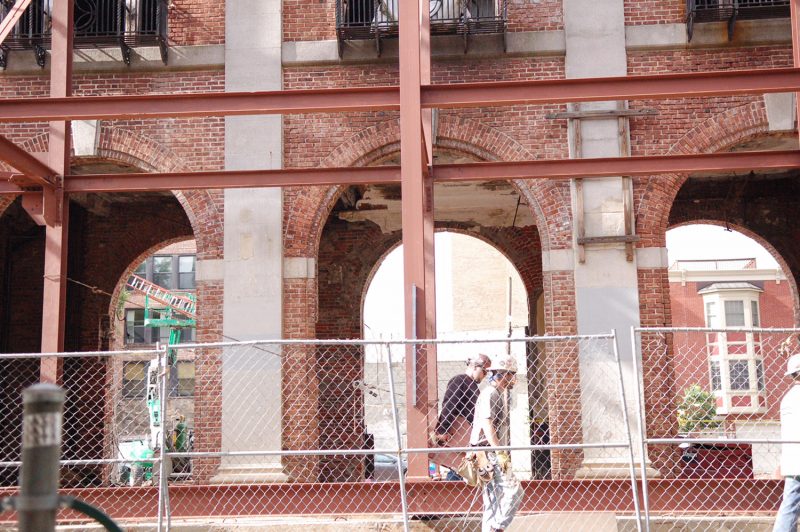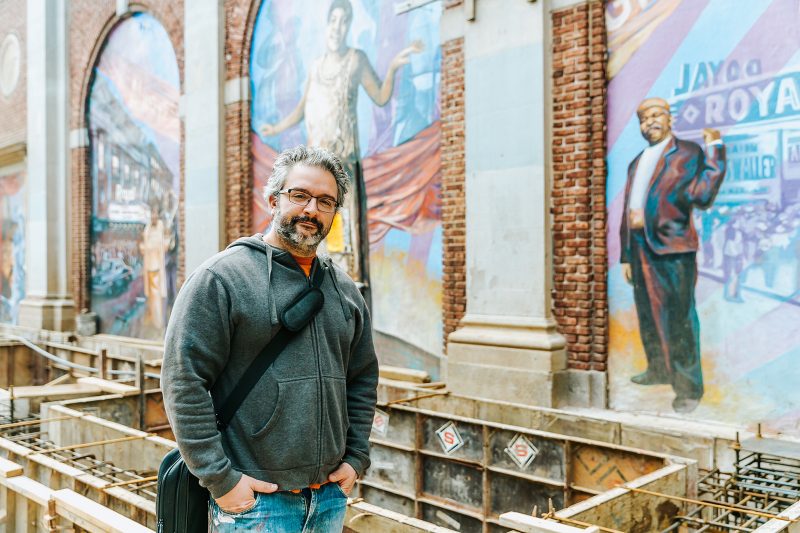Before Bob & Barbara’s Lounge was famous for its Thursday night drag show, people came to the neighborhood establishment to hear tenor sax player Nate Wiley perform, a gig he played weekly for almost 20 years. It’s been almost five years since Wiley & The Crowd Pleasers jammed at 1509 South Street, but passersby could still see him directly across the street from Bob & Barbara’s, at 1524-1534 South Street, in the left foreground of the Royal Theater’s mural alongside other familiar faces such as Miss Jessie (who owned a hat shop on South Street until recently) and Ron of Ron’s Ribs (now Tico’s Tacos).
Pedestrians could also search the violet and indigo toned multi-panel mural for some of the jazz icons — Fats Waller, Pearl Bailey, Billy Paul, and Bessie Smith — who once played at The Royal, Philadelphia’s oldest and largest African American run theater, built in 1919.
Until last week. (May 18th, to be exact.)
Dismantling a keystone of Philadelphia’s music history

With the new development causing piles of bricks to disappear from the exterior walls of the theater daily, Wiley and the rest of the life-sized neighborhood figures and larger-than-life musical legends immortalized in the mural recently vanished from public view.
Concerned neighbors and onlookers have been watching the demolition progress, wondering about the fate of the mural that once graced the arched doorways of The Royal. But rest assured, the murals are not intended to be gone for long. OCF Realty plans to repurpose the central mural elements into the mixed use residential and retail space that will be constructed on-site.
“From day one it’s been our intent that we do what we can to keep [the mural panels], knowing the attachment people have to them,” explains Liz Todd Scott, OCF’s project manager for the Royal project who has been working closely with the Mural Arts Program to preserve the mural. “It is the image that people have pinned the memories of the building on.”
Scott, who lives in the neighborhood herself, has received countless inquiries from local residents about the mural. One such inquiry came from Brandon Washington, the son of Ron of Ron’s Ribs, who asked to take the central murals panels (and in particular the right section with his father) if they were not going to be reused.
When the murals, painted on plywood panels, were detached from the building last week, Scott made sure to give the foreman and the crew clear instructions to handle them with great care due to the obvious significance they hold for the neighborhood. If they didn’t, Scott said, it would look to Brandon and others “like they’re handling his father’s remains inappropriately.”
The jazz greats live on

But Eric Okdeh, the public artist who painted the mural in 2005 in collaboration with the Mural Arts Program, never expected it to be considered so precious. He was very pleasantly surprised when he received an invitation from Scott to meet with her and Zambia Greene, Director of Mural Operations at the Mural Arts Program, to discuss the future of the public artwork.
Okdeh maintains that it was never supposed to have had this long a life in the first place. “When I got this commission, the expectation was that the building would be developed within a couple years,” he recalls. “I figured [the mural] only had a few years as a lifetime. And as a public artist you make your peace with that and do a good job documenting the heck out of it, because you never know what can happen once it’s in the public.”
“All things considered, it’s had a heck of a life,” Okdeh continues. “I’m really grateful that it’s had the lifespan that it’s had. And I’m really happy to hear that it’s been so well received, that people were concerned for it and want to see it live longer. I think that’s super cool.”
While many may lament the fact that the Royal mural will outlive the historic theater it pays tribute to, it is nonetheless heartening to see the concern for an artwork that has graced South Street for just over a decade.









